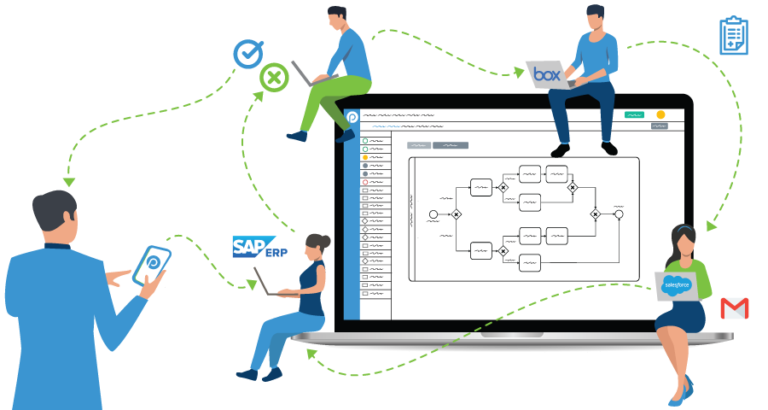The average employee spends 40 hours per week at work—but a shocking 36% say they “hardly ever” know what’s going on within their organization. This lack of understanding has obvious consequences: disengaged employees are far less productive. With an overwhelming number of team members consistently feeling “out of the loop,” it’s no wonder why leading organizations are turning to process flows to boost transparency and bolster productivity.
What are process flows?
Process flows are an excellent way to standardize how things are done. In many business settings, employees perform processes on auto-pilot with little documentation of the steps involved. This can leave other team members in the dark: they’re unsure who carries each responsibility and have limited understanding of the steps required to see a project through to success. The result? Employees that feel removed from the bigger picture.
Process flows overcome these challenges by providing a crystal-clear, step-by-step guidebook for each process. Some professionals see process flows as a “mind map,” extracting work steps from individual memory into a shared, communal record. They typically come in the form of a flowchart, serving as an easy-to-follow visual aid for anyone to review.
The chief benefits of a process flow are:
- Show other employees every step in a process: Instead of a long, drawn-out explanation, it’s a quick way to teach upper-level management and other team members who are unfamiliar with the process.
- Find out ways to improve an existing process: What’s slowing things down? Where can you implement new technology to make things more efficient? Are there any redundancies? By shining a spotlight on every step involved, you can find new ways to streamline internal activity.
These helpful diagrams use different symbols to indicate decision points, tasks, inputs, and other elements important to the success of a process. They not only connect individuals and departments, but can show how information travels between teams, or show where an app or other software integration is needed.
3 examples of simple process flows
Process flows can be as simple as approving a time-off request to more elaborate steps involved in global supply chain management. Here, we’ll illustrate simple process flows to break down the tasks involved in three different types of common business activities.
Time-off request
Think simple forms like time-off requests don’t need a process flow diagram? Think again: employees across the U.S. and U.K. waste 40 million hours each month toiling with internal HR forms like expense reports and PTO requests. Even the simplest processes can benefit from a streamlined process flow diagram.
- Start Process: Employee requests time off
- System checks against available PTO
- Review by direct managers
- Distribute calendar notification informing team members of time away
- Submit to HR for filing
- End Process
By illustrating each step involved, you can also identify prime candidates for automation and other software to help expedite approvals.
Marketing and sales initiatives
When it comes to attracting new customers, webinars are a smash hit for marketers. They’re an incredible way to convert casual browsers into top-paying clients, and businesses are orchestrating bulletproof marketing and sales processes to close the sale. Here’s how.
- Start Process: Prospect registers for a webinar
- Email prep materials like worksheets or supporting case studies
- Follow up with an email reminder one week before webinar
- Send calendar reminder one hour before webinar start
- Webinar date
- Compile list of phone numbers for leads who watched the full webinar
- Sales manager approves qualified lead list
- Assign each sales team member an equal number of leads
- Sales team members make follow-up calls
- End Process: Report on sales conversions
Pairing a powerful webinar with a well-thought-out process flow is the one-two punch few prospects can resist. By ensuring everyone involved is properly in the loop, you can create an irresistible sales and marketing strategy.
New-hire onboarding
First impressions leave a lasting impression, and for a business, their onboarding process is often the first taste of a company’s culture. Studies show that 69% of employees who have a positive onboarding experience will stay with a company for three years. Sloppy, unstructured, disorganized processes have the opposite effect—they not only drain internal efficiency, but hamper an organization’s ability to retain top talent.
Here is a sample process flow for a short onboarding process that involves several departments:
- Start Process: New Employee Hired
- Prepare parking pass
- Security approval
- Compile up-to-date HR links into an email
- Grant access to necessary databases
- Manager approval
- Schedule team welcome lunch
- Update team member calendars
- End Process: First Day
Codifying the steps involved leads to an organized, welcoming onboarding experience that leaves a positive impression on new hires.
Process flows = a recipe for success!
Process flows are an A+ strategy for building an engaged, productive workforce. After all, highly engaged teams can boost profitability by 21%. Are you ready to supercharge your organization’s output by using process flows?


